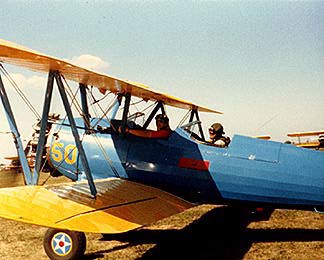

The Ohio River looked beautiful, that day, saturated blue-green instead of the customary dull brown. We were crossing it from north to south, and had almost reached the southern shore. With the early evening sun behind and to our right, we had a clear upstream view of the bridges spanning it at Louisville, and the downtown area of the city was close at hand. We were returning from some adventure or other, I don't remember what, in southern Indiana, and I was flying the Stearman from the back cockpit, while my dear friend, instructor and fellow lover of old airplanes, Bob Livingston, sat taking in the sights from the front.. We were at only 1200 feet, on our way to Bowman Field, but slipping under the controlled airspace of Standiford Field. All was well with the world, the air was silky smooth and the Continental W670-6N, 220 horsepower radial engine was purring like a kitten. Then I saw the smoke.
It was just a little puff of blue-white, whipping from the engine past me in the slipstream, gone in less than an instant. Did I really see that? Another puff. No doubt, this time. Flipping on the intercom, I told Bob to watch the right side of the engine. In a moment, another puff, then another. Bob wiggled the stick and said, "Let me have it." Suddenly, the plane was thrown into a steep, diving turn to the right, toward the southern shore. We descended rapidly to 500 feet or less, then turned left and continued to descend as though for a landing. I had no idea what was happening, because there wasn't a place to land within 10 miles. We were just west of the heart of the city, in downtown Louisville, for God's sake! What was he thinking?
The apparent approach continued, headed for a long grove of trees on the river bank, and I tightened my seat and shoulder harness as tightly as possible. Obviously, there was more of a problem than I was aware of, and we were making an emergency landing. But where? Why?
Then, tucked into that grove of trees, I saw a very small, narrow strip of grass. A landing strip? Surely not. But, it was, indeed. Bob set the plane down on it and got hard on the brakes to stop before we smashed into a huge pile of concrete slabs blocking the end like a train-stopping barricade. Whew! Something new, every day.
We taxied into what can be described in no other way than the back yard of a place of business, a dilapidated old corrugated metal building, and Bob shut the plane down. Finally, I could get some answers.
This was a place known to him, run by a friend from his old flying days, to whom I was dutifully introduced, and he had stopped to figure out the problem. It turned out to be nothing but drops of oil coming from the rocker box and vaporizing on the exhaust manifold, and a minute with a borrowed wrench solved it.
With a hearty thanks and farewell, we were off, again. Well, not just like that. The wind was calm, and that meant we needed every last inch of runway to get the plane out of there in one piece, because there were tall trees at the end. Time for another old pilot's trick. Bob started our take-off roll in the back yard, at right angles to the strip, turned sharply onto the strip while already moving 15-20 mph, tail up, adding full throttle as he did so. We barrelled down the short and very narrow strip, trees actually overhanging it on both sides so it appeared we were taking off through a tunnel, and we cleared the trees with ease. Those old dogs are something to behold.
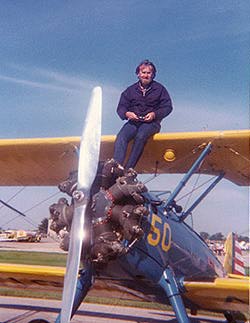 On another day, Bob asked if I'd like to go to a fly-in at Rough River State Park, but added that he had a favor to ask. A friend had just finished a total restoration on a J-3 Cub, and Bob had agreed to test it before it was delivered to its owner in Chicago. It was hangered at a small field at Lanesville, Indiana, just across the river, and Bob suggested I fly him over in the Stearman to pick it up. We would then fly formation to Rough River, spend the day and then reverse the procedure and return. A good plan, it seemed, so we set the wheels in motion, as it were.
On another day, Bob asked if I'd like to go to a fly-in at Rough River State Park, but added that he had a favor to ask. A friend had just finished a total restoration on a J-3 Cub, and Bob had agreed to test it before it was delivered to its owner in Chicago. It was hangered at a small field at Lanesville, Indiana, just across the river, and Bob suggested I fly him over in the Stearman to pick it up. We would then fly formation to Rough River, spend the day and then reverse the procedure and return. A good plan, it seemed, so we set the wheels in motion, as it were.
We left home base early in the morning and made the short hop to Lanesville. I had never been there, but was looking forward to another chance to use a grass strip. If I'd known the strip, I wouldn't have been so anxious, believe you me. The strip was an East-West one, fairly long, even had runway lights. I suspect, though, that it was built on an old roller-coaster site, because I've never to this day seen such an up-and-down strip. There was nothing level about it, it was either uphill or downhill at every spot, and not gently so.
I made the landing with considerable coaching from Bob, and, although it wasn't a pretty thing to see, I didn't break anything.
Bob fired up the Cub and left before me, and I tackled the roller-coaster takeoff. Wow! Just as I was about to reach flying speed the ground fell away sharply, and I was flying before I wanted to. Then I wasn't, then I was. Fighting to wrestle the blasted thing into the air, I let my attention stray from the job of keeping her headed straight down the runway, and I have no idea how I missed the runway light which I saw disappear under the right wing while the wheels were still rolling.
Heaving a sigh of relief, I climbed away from the field, glad to be gone. Catching the Cub was no problem, but staying with him was. There was no way to fly formation on him, because he was far too slow for us to match speeds. I flew big "S" turns and circles behind him all the way to the lake, and was glad to get there.
We had a grand day looking at all the planes, giving people rides in the Stearman and just hanging out. For an hour, Bob let me fly the Cub, which was a lifetime thrill. Like flying a balloon on this hot day, and I felt I could get out and walk anytime I chose, it was so slow. I got to make several landings and takeoffs, but didn't get to solo the plane because Bob didn't own it.
In mid-afternoon the wind began to pipe up, and we decided to head back to Lanesville. By the time we arrived there, the wind was up to 25 knots and directly across the strip. There was no way we could take these two old tail-draggers into that strip without breaking them, so we were forced to head to Bowman, our home base.
Now, we realized we were in a bit of a fix. We were both in trouble with a high wind, especially a crosswind. And, Bob had no radio, so he couldn't talk to the tower to find out what conditions were. He would have to trust my judgement and follow me in.
I talked to traffic control, explained our situation and asked them to give Bob light signals to communicate with him. Wind was 25 knots gusting 35, but was, thankfully, almost straight down the runway, only 10 degrees off our nose.
I made the landing with considerable fear and trepidation, but without incident, and carefully got to the taxiway, then stopped to watch Bob. His plane's stalling speed was just a little higher than the wind, and he looked like a helicopter making a vertical landing. He was stopped almost before he hit the ground. We both taxied very gingerly to the tie-down pad, making absolutely sure to keep the stick full back to hold the tail down and the stick fully into the wind to spill lift from the upwind wing. We made it without incident, and the Big Orange tasted particularly sweet, this time.
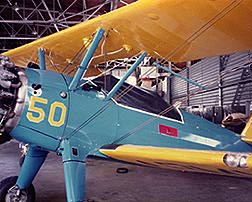 These little adventure are only two of the many which I experienced while flying the Stearman. The eight years I owned her seemed filled with such episodes, most of a more relaxed and calm character, but all pleasant and instructive. My fellow traveler, Bob Livingston, was involved in many of them, and owning the plane would not have been the same without him. He was a man of considerable flying experience, but more importantly, he understood and appreciated a different world of flying than most pilots of today. I'm proud to say he taught me a lot about that world while teaching me to fly the Stearman.
These little adventure are only two of the many which I experienced while flying the Stearman. The eight years I owned her seemed filled with such episodes, most of a more relaxed and calm character, but all pleasant and instructive. My fellow traveler, Bob Livingston, was involved in many of them, and owning the plane would not have been the same without him. He was a man of considerable flying experience, but more importantly, he understood and appreciated a different world of flying than most pilots of today. I'm proud to say he taught me a lot about that world while teaching me to fly the Stearman.
We made some distant trips, but mostly we stayed close to home. Bob seemed to know every small landing strip within a hundred miles, mostly private, some abandoned, all challenging, and we made it a game to seek them out. The typical flight for us was to visit some old friend of his with a little grass strip out in the boondocks, usually with a hanger for a small plane, no windsock. I loved those grass strips, because that's what the Stearman was built for, and landing on grass always felt better than landing on asphalt or concrete. Occasionally we'd be treated to the sight of some old antique airplane tucked away in a barn. Some had been restored and were being maintained, maybe even flown occasionally, but far too many were slowly sinking into the dust, old fabric and wood moldering away, engines quiet forever. Interesting, but sad.
We frequently packed a lunch and ate it in the cool shade of the wing. Eating a Moon Pie, sipping on a warm Big Orange drink and just spending time together was usually part of the ritual. Of course, Bob being what he was, and I being hungry for what he knew about flying old airplanes, the lessons never stopped.
Many a pleasant day was spent on these little voyages of discovery, in all seasons and weathers. We froze in her and sweltered in her, fought the wind and dodged the rain and clouds. Pure seat-of-the-pants flying, the very best kind. I flew and flew and flew, and was pleased to eventually begin to feel the plane was mine in a meaningful way.
Traveling in an airplane has never been of much interest to me. I don't mind going somewhere, but only if some flying activity is waiting at the other end. Putting around as Bob and I did so many times suited me exactly, but even that was never the thing which really lit my fire. Aerobatics. That's the thing for me. I figured that out early in my Naval training, and it never changed.
Nothing ever suited me more than just flying alone out to the practice area and spending a couple of hours turning the old bird "every which way but loose". There are many, many planes more suitable for this than a Stearman, especially one with the original Continental 220 horsepower engine, but they were never of any interest to me. I like the old ones, the challenge of doing acrobatics in a plane which requires more than just horsepower.
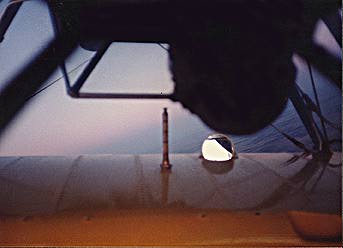
I spent many a marvelous hour doing that in the old plane, and it added an element to my skills which always made me proud. Most modern pilots have never been in a plane turned upside down, and they might very well be in severe trouble if they found themselves in that situation. Not even a simple spin is taught most of them, these days. Pity.
Level at 3500 feet on a clear day under a sparkling blue sky with scattered cumulous clouds looking for all the world like piles of whipped cream. Ninety degree turn left, then right, to inspect the area and make certain you are alone. Pick a visible landmark over your nose. Pull back the power to idle, hold the altitude as the speed decays. Keep raising the nose, raising the nose while keeping the heading with the rudder. Because of the stall strips on each wing leading edge, the plane will stall smoothly and quickly straight ahead about the time you have the stick back as far as it will go, right in your crotch. The instant the nose begins to drop, kick in full right rudder and hold it. The plane will drop its nose sharply down and rotate to the right, quickly. If you do nothing else, just hold what you have, you will be in a full spin. Before it has rotated ninety degrees, though, kick in full left rudder and hold it. The plane will stop rotating, then rotate in the opposite direction. Before it has rotated 180 degrees, or 90 degrees left of your original heading, kick in full right rudder, again, and hold it. Back to the right you go. Repeat this sequence three or four times, all the while keeping the stick full back. Each reversal of rotation will come more quickly than the preceding. When you've had enough, pop the stick far forward to break the stall and get the plane flying again. At the same time, use the rudders to stop the nose right on your original heading, with your landmark straight ahead. You are now in a steep, power-off dive. Pull out, add power when the speed decreases back to cruise, and resume level flight.
You have just done a "falling leaf". Great fun, wasn't it?
Loop, spin, barrel roll, Immelmann, Cuban eight, slow roll, point roll, snap roll, hammerhead stall, split "S"... I love them all. All can be done in a stock Stearman, but it takes some learning, some good energy management, excellent timing, some planning ahead and understanding of what is happening. A little luck doesn't do any harm.
Because it was built as a trainer, the Stearman was built very tough. You will pass out long before you break her with any of these maneuvers, either positive or negative. Stable, safe, reasonably capable and a great deal of fun. Quite a machine. Just the right one for an old man who loves the old ways, the old planes and the old pilots, who has no desire to be a stunt pilot or an airshow performer, but just wants to have some fun and come home safe at the end of the day.
She was built as a trainer, and she never stopped doing that as long as I had her. She was a class act.
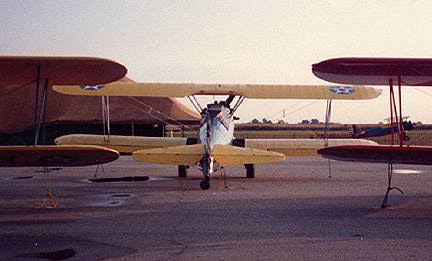
Copyright © B. E. Spencer 2001 All rights reserved.